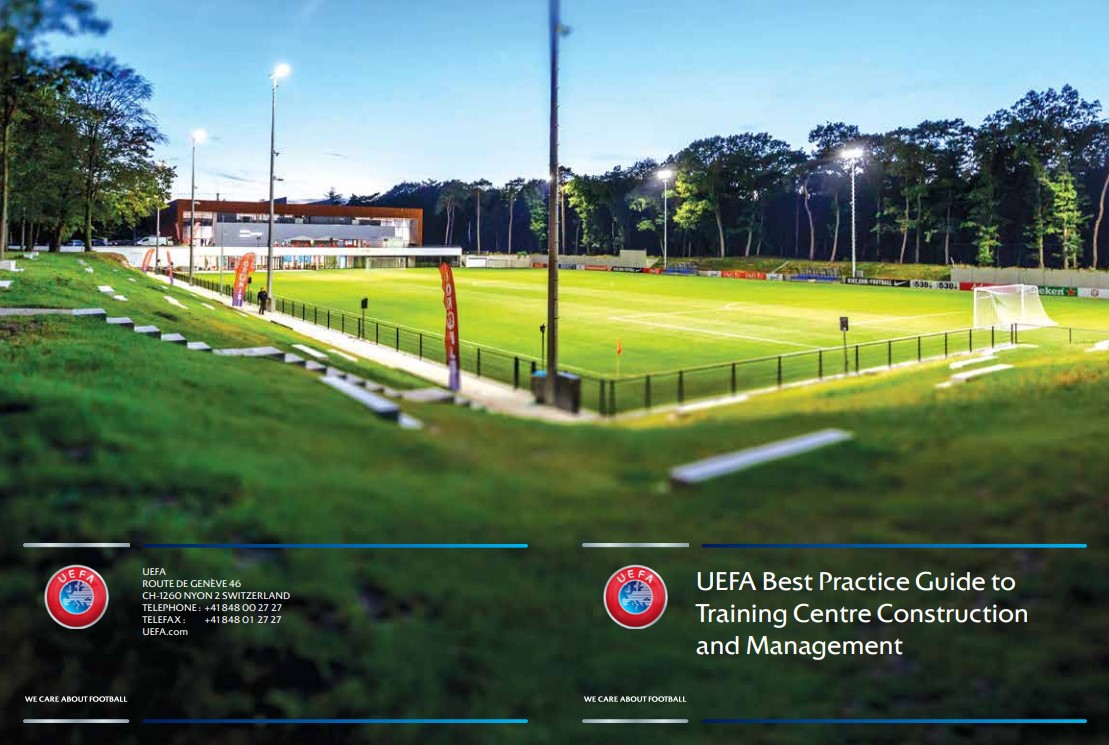Constructing and renovating UEFA training facilities
Contents |
[edit] Introduction
In February 2021, UEFA published a guide to help clubs and national associations plan for constructing and renovating training centres. The document, ‘UEFA Best Practice Guide to Training Centre Construction and Management’, provides an overview of factors to consider when looking to invest in new facilities or improve existing sites. The guidelines also provide generic advice about facility and service requirements for training centres.
Designed for organisations of all sizes and expertise, guidance is offered for training centre design, construction and management from a sporting and operational perspective. Key areas include:
- Infrastructure.
- Process and function.
- Training facilities.
- Sustainability.
- Accessibility.
[edit] Five training centre suggestions
[edit] Each project is unique
There is no one-size-fits-all model but specific best practice examples and business models can be used as reference points to build a bespoke facility regardless of how it will be used (and who will be using it).
[edit] Build a team to succeed
Just as on the pitch, the composition of a team brought together to deliver a project is crucial. A wide variety of knowledge and skillsets are needed to ensure all stakeholders are considered, whether that is providing the right facilities for coaches and players, or addressing the requirements of marketing, media and community opportunities.
[edit] Training, testing, rehab and recovery
The importance of recovery and rehabilitation have long been accepted as essential by coaches and sports scientists for athletes to perform at their best during increasingly intense schedules. Modern training centres now reflect the advances made in this area in the array of facilities installed at the elite level. Performance testing labs are increasingly common in order to identify key physical traits and help detect and avoid burnout or injury.
[edit] Technology and future proofing
From monitoring player performance to tracking the length of grass, there is now barely a detail that is left to chance. Popular uses of technology include live GPS, automated cameras, giant screens, digital signage and control centres as well as interactive training aids to improve technical skills.
[edit] Support through sustainability
Increasingly, sustainable and environmentally friendly designs and construction schemes are enjoying political, public and financial support. Sustainability is a key issue in the development of infrastructure, and clubs and associations that take account of such matters are regarded as being representative of their local communities. A strong sustainability strategy can help achieve commercial goals, as well as reinforcing positive values.
The following are all key areas in this regard:
- Design.
- Construction method.
- Lighting and energy use.
- Transport.
- Landscaping and biodiversity.
- Re-use and recycling (including reduction of water consumption).
- Generation of waste.
[edit] Related articles on Designing Buildings Wiki
- Accessibility in the built environment.
- Best gym architecture in the world.
- Best practice.
- Fitness studio design.
- Forest Green Rovers football stadium.
- Interview with Kevin Borg, founder of KJB Building Consultants.
- London 2012 Olympic Stadium.
- Scunthorpe Sports Academy.
- Stadium.
- Sustainability.
- Sustainable materials.
- The Family Stand, Dover Athletic Football Club.
- Types of building.
[edit] External resources
Featured articles and news
International Electrician Day, 10 June 2025
Celebrating the role of electrical engineers from André-Marie Amperè, today and for the future.
New guide for clients launched at Houses of Parliament
'There has never been a more important time for clients to step up and ...ask the right questions'
The impact of recycled slate tiles
Innovation across the decades.
EPC changes for existing buildings
Changes and their context as the new RdSAP methodology comes into use from 15 June.
Skills England publishes Sector skills needs assessments
Priority areas relating to the built environment highlighted and described in brief.
BSRIA HVAC Market Watch - May 2025 Edition
Heat Pump Market Outlook: Policy, Performance & Refrigerant Trends for 2025–2028.
Committing to EDI in construction with CIOB
Built Environment professional bodies deepen commitment to EDI with two new signatories: CIAT and CICES.
Government Grenfell progress report at a glance
Line by line recomendation overview, with links to more details.
An engaging and lively review of his professional life.
Sustainable heating for listed buildings
A problem that needs to be approached intelligently.
50th Golden anniversary ECA Edmundson apprentice award
Deadline for entries has been extended to Friday 27 June, so don't miss out!
CIAT at the London Festival of Architecture
Designing for Everyone: Breaking Barriers in Inclusive Architecture.
Mixed reactions to apprenticeship and skills reform 2025
A 'welcome shift' for some and a 'backwards step' for others.
Licensing construction in the UK
As the latest report and proposal to licence builders reaches Parliament.
Building Safety Alliance golden thread guidance
Extensive excel checklist of information with guidance document freely accessible.
Fair Payment Code and other payment initiatives
For fair and late payments, need to work together to add value.
Pre-planning delivery programmes and delay penalties
Proposed for housebuilders in government reform: Speeding Up Build Out.
High street health: converting a building for healthcare uses
The benefits of health centres acting as new anchor sites in the high street.

























